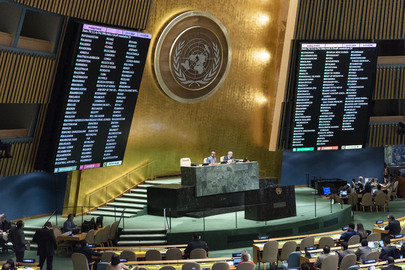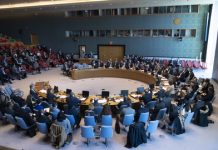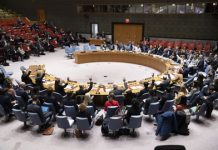Mita Hosali: It’s my great pleasure to introduce Amandeep Singh Gill. He is the Secretary-General’s Envoy on Technology. You know, one of the issues that comes up with digital innovation and AI is the issue of guardrails. Is it possible on a global level to put guardrails in place? What is your thinking about how we can go about putting guardrails in place?
Amandeep Singh Gill: You know, when technology is moving fast and AI is definitely moving fast and it has wide implications and also some uncertainty around the implications. Then we might get confused of what should we protect against, where should we put the guardrails? Are we going to throttle innovation if the guardrails are too stiff? And not agile enough? So, this is where I think the norms inside the UN are so helpful. You have these international human rights treaties, you have commitments on gender and the environment, you have the Sustainable Development Goals… So, they are like our compass, they guide us through this uncertainty. I think they are very useful for building these guardrails. We should have a regular dialogue on AI policies, on AI governance so that we develop a common vocabulary. How do we speak about these risks and harms? When we talk about protecting against them, are we hiding behind words or are we clear about our actions and our words that describe those actions and then also learning from each other? I’m a big fan of international learning. In the rightly curated dialogue space, you can learn from each other. You may not say anything in the room, but you go back and reflect with colleagues.
Mita Hosali: We know, top data centres in the world are actually in the West. One of the key concerns is about inclusion of the Global South in whatever happens next. Do we find ways of making sure that this is an equitable advance for the world?
Amandeep Singh Gill: Personally and professionally, this is the most important question. There is no African country in the top 50 in AI and you have to struggle to find the first high-performance compute cluster capable of training some of these large language models in Africa. There’s only one in Morocco. We have an issue there in terms of the infrastructure. We also have an issue in terms of the talent. The talent is highly concentrated in a few places. Africa, Asia, Latin America have a lot of talent, but sometimes their incentives are not there to keep the talent at home. And then in terms of access to data, also large-scale data sets may not be there in a small economy or in a region. So, all those enablers need to be actioned. There’s also a very important question of financial resources, including the need to address energy poverty. 600 million people don’t have access to regular energy and you can’t run a compute cluster for AI if you don’t have reliable power.
We have to work on many fronts to bridge the AI divide. There are three critical areas where we must concentrate our resources. The first of them is, you know, capacity development of public officials, ministers, senior civil servants, so they understand the importance of this and how it should be related to their existing work on addressing the connectivity divide, building digital public infrastructure and building innovation ecosystems. Second, providing access to compute data and talent to researchers and innovators so that they can start building homegrown solutions. And third, international cooperation and openness in terms of sharing some models that have worked in other places. And that’s why this idea of a capacity development network. So, those are kind of priority items that have been identified and action has started. The Google CEO announced 120 million funding for a talent development plan. There have been other announcements. So it’s amazing to see the interest and people stepping forward to offer help for putting a floor under the AI divide.
Mita Hosali: I think in the Global South, in the developing world, it’s often the case that governments and the public sector are the drivers when it comes to kickstarting some of these innovations. But increasingly, I think, it is just a reality that without the private sector, we’re not going to be able to go anywhere. So how is it possible to harness this synergy between the public sector and the private sector, especially when it comes to lower income countries?
Amandeep Singh Gill: When speaking about the digital economy, I like to speak about some foundations. One is connectivity, meaningful connectivity. We still have 2.6 billion people that are not connect to Internet. The other is digital public infrastructure that allows a demand side pull on the supply side of connectivity. And then obviously we need frameworks in place, incentives and regulatory regimes that stimulate the development of the digital economy. And finally, the talent that’s needed. The computing talent, but also the business-related talent. You know, 500 million people have come into the modern financial sector in India in 10 years as compared to 40 years that would have taken with old methods. And then you have use cases there where the business comes in -your point about public and private working together. Small businesses in e-commerce in fintech who can use even a kind of rudimentary level of digital penetration to build up the trust that you know this contributes to the digital economy. And then there are areas where public and private sector can come together – health, agriculture – where the market incentives are not strong enough. But you can build through partnerships. Some of those exciting use cases which stimulate the digital economy, inclusive digital economy.
Mita Hosali: Thank you so much for that overview!
This is such an exciting week with so many important conversations happening here at UN headquarters. Welcome here to this session. It’s about women in tech.
So, first on my left is Sarah Steinberg, Head of Global Public Policy Partnerships, LinkedIn. To her left is Tami Bhaumik. She is Vice President of Civility and Partnerships for Roblox. I love the expression ‘digital civility’. I wish we could see more of that. And on the far left is a colleague from UN Women, Hélène Molinier, Senior Advisor on Digital Cooperation at UN Women. So you’re very, very well qualified to speak about this issue of women and technology.
There is about 25 per cent women in the field of tech. The numbers may change a bit here and there. And when you climb up the ladder to the executive level, of course it drops about 11 per cent of women. When you look at AI researchers around the world, there are about 80,000 or so. And only 18 per cent of them are women. When it comes to women in tech, where are we in this world? How has the advance, the inroads, made by artificial intelligence affected women? How has it impacted governance? And how might it really transform the world that we live in?
So, Sarah, you’re with LinkedIn. How can we make sure that women and young girls are encouraged to seek out roles and skills in the tech field? That’s one part of my question. The other part is employers. How can they help to upskill, retrain women in the workforce where technology and AI is having a massive and somewhat damaging effect?
Sarah Steinberg: We are at a pivotal moment for women in the workplace. And at LinkedIn we can see this because we have incredible data and insights from having over a billion members in more than 200 countries around the world, and we’re using that to really understand what this landscape looks like for women and for many years, we were seeing, you know, the same old story: steady but insufficient progress on gender equality in the workplace. We don’t see that anymore, actually. So, we’ve seen a decline in the rate of hiring of women into leadership globally so that we’re now back to 2019 levels. And when it comes to the industries and the fields that are really driving the future – STEM, the green economy, AI – we see women significantly underrepresented and not making sufficient progress in closing that gap. I just want to provide that context because when we talk about sort of the impact of generative AI, that’s sort of the context in which this technology is being introduced. And at LinkedIn, we have research showing that one third of women globally work in occupations that we think are likely to be disrupted by generative AI, compared to just one quarter of men. I think, ultimately this technology is going to create more jobs, but we have to be aware of the fact that it’s going to reshape the jobs and skills that we already have. And this is why LinkedIn is really dedicated of being in this conversation and understanding how that is playing out.
Mita Hoisali: Tami, just moving on to you next, working as a senior executive for Roblox, I understand you have something like 80 million daily active users of your platform, and this is a huge responsibility and it gives you access to young minds. So, what are Roblox’s plans when it comes to developing and building STEM skills for young girls and female developers?
Tami Bhaumik: Thank you for inviting me. So, in Roblox, we have 79.5 million daily active users on our platform. In addition to that, we have millions of developers and creators that are developing these experiences on Roblox. Roblox doesn’t create any of the experiences or games on the platform. We are a technology company that really invests in developing the tools that allow people to be able to create. Experience is born out of their own imagination. And the reason why I’m so excited about the future and Gen.AI and the opportunity that it will afford women and girls and marginalized individuals, is that it opens up and democratizes opportunity. If you don’t want to learn how to program, you’re not good at math, if you just have no interest in the science, but you have an amazing idea and you have an amazing story to tell it, it’s very, very exciting to have Gen.AI and to have the ability to create those experiences without having to code. And so, I believe that Roblox really, really nails down so much of the SDG goals in terms of providing opportunity to level-set gender equality, making sure those voices who are very, very faint in the background really come to the forefront. I think that Roblox has a huge opportunity to make some major impact in the world when it comes to bringing up that equality.
Mita Hosali: Hélène, just moving on to you. Of course, UN women is looking at all the elements of women in tech. And there’s one angle that’s been talked about a bit and I’m not sure we have an answer yet. And that is that AI is only as good as the data that you use to train. And when it’s insufficient on the gender front, then we’re creating a very skewed AI. What do you have to say about that?
Hélène Molinier: Indeed, the quality of data sets and how representative they are is a key issue to get good results whether we are looking at LLMs or at just more narrow AI. But this is not the only aspect. I think we have to be very attentive to look at bias at every cycle of AI system development. You have to look at it in the databases. You have to look at it also in the solutions that you use AI for. And this is human that should be making those decisions, for example, to use AI to decide about credit worthiness of people, you know, the parameters to set whether someone can have access to credit or not. It’s still very much being in control of human decision. When you look at evaluating this, this system, and making the decision to put it on the market or not. We see a lot of products that are put in the market and that can be still harmful, that still have this bias and stereotypes, whether it’s in image generation or chat bot moderation. And still they are put in the market. And these are human decisions that lead to that. So, good data sets are the foundation, but we also need to look at the whole cycle.
Source of original article: United Nations (news.un.org). Photo credit: UN. The content of this article does not necessarily reflect the views or opinion of Global Diaspora News (www.globaldiasporanews.com).
To submit your press release: (https://www.globaldiasporanews.com/pr).
To advertise on Global Diaspora News: (www.globaldiasporanews.com/ads).
Sign up to Global Diaspora News newsletter (https://www.globaldiasporanews.com/newsletter/) to start receiving updates and opportunities directly in your email inbox for free.




























